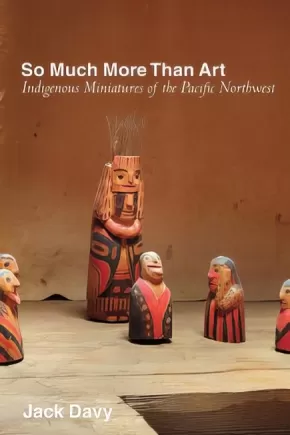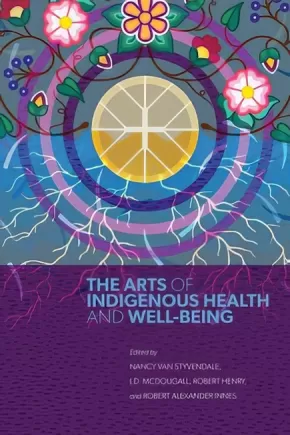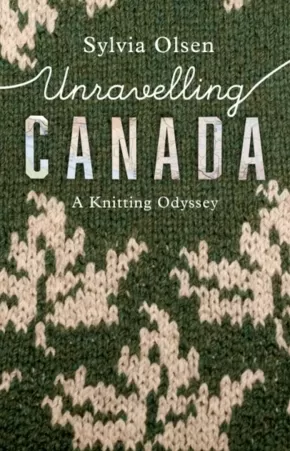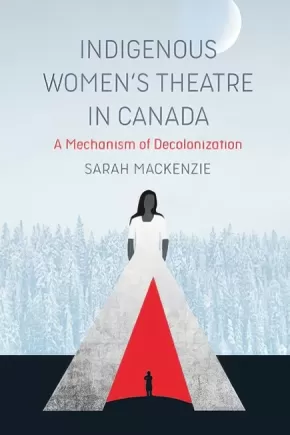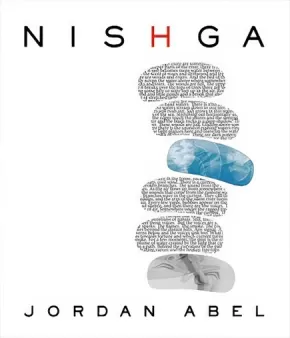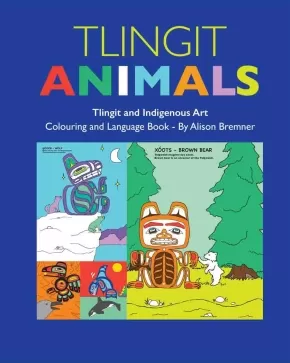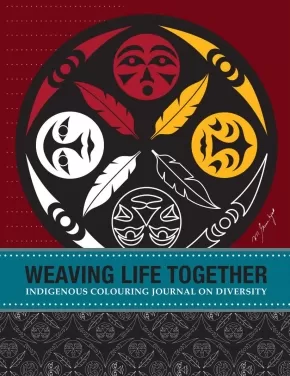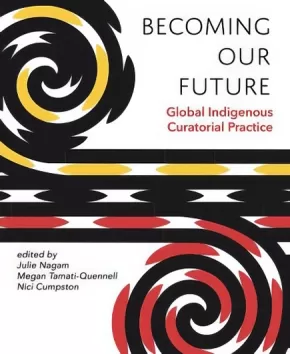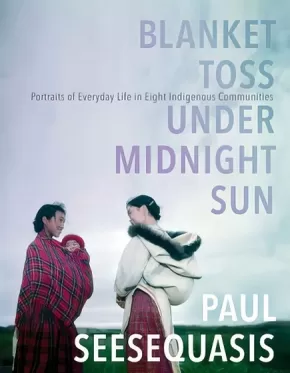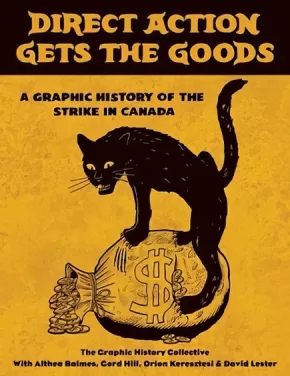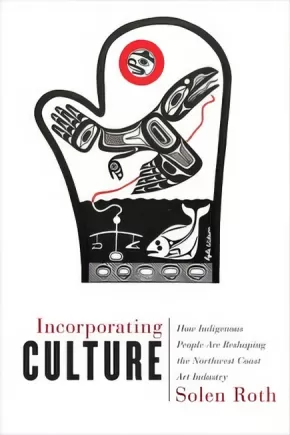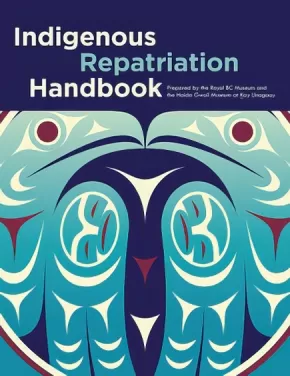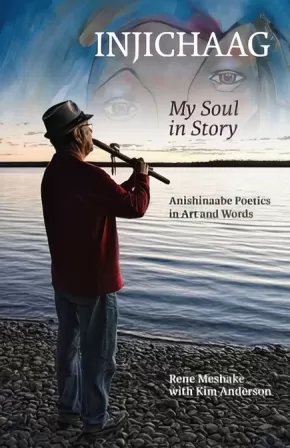
Art
61
-
75
of
139 Results;
Sort By
Go To
of 10
So Much More Than Art: Indigenous Miniatures of the Pacific Northwest
$89.95
Format:
Hardcover
Text Content Territories:
Indigenous Canadian;
ISBN / Barcode: 9780774866552
Synopsis:
Synopsis:
Miniature canoes, houses and totems, and human figurines have been produced on the Northwest Coast since at least the sixteenth century. What motivates Indigenous artists to produce these tiny artworks? Are they curios, toys, art, or something else?
So Much More Than Art is an original exploration of this intricate cultural pursuit. Through case studies and conversations with contemporary Indigenous artists, Jack Davy uncovers the ways in which miniaturization has functioned as a subtle form of communication and, since contact, resistance in the face of aggressive colonization. His interviewees dismiss the persistent assertion running through studies of material culture that miniatures were no more than toys for children or souvenir trinkets. They are in fact crucial components of satirical opposition to colonial government, preservation of traditional techniques, and political and legal negotiation.
This nuanced study of a hitherto misunderstood practice convincingly demonstrates the importance of miniaturization as a technique for communicating complex cultural ideas between generations and communities, and across the divide that separates Indigenous and settler societies. So Much More Than Art is also a testament to the resilience of the Indigenous peoples of the Northwest Coast.
Students and scholars of anthropology, museum studies, Indigenous studies, and art history will find this work a valuable addition to their libraries, as will museum, arts, and heritage professionals.
Reviews
"So Much More Than Art goes beyond other studies by demonstrating how Northwest Coast Indigenous artists use and have used miniaturization not only as an artistic practice but in provoking interventions in social relations and as a strategy of communication and resistance in the face of colonialism." — Karen Duffek, curator, Contemporary Visual Arts and Pacific Northwest, Museum of Anthropology at UBC
"Drawing heavily on the knowledge and opinions of Indigenous experts from communities all along the coast, Jack Davy invites us to think more critically about Northwest Coast miniatures, and leaves us with a framework with which to do so." — Kaitlin McCormick, curator, Western Ethnology, Canadian Museum of History
Educator Information
Table of Contents
Introduction
1 Practice and Play: The Makah
2 The Haida String: Northern Peoples
3 Tiny Dancers and Idiot Sticks: The Kwakwaka’wakw
4 Small Foundations: Tulalip Tribes
5 An Elemental Theory of Miniaturization
6 Analysis of Technique and Status
7 Miniature Realities
Notes; References; Index
Additional Information
224 pages | 6.00" x 9.00" | 21 Photographys, 7 Tables, 2 Charts/Diagrams | Hardcover
The Arts of Indigenous Health and Well-Being
$27.95
Editors:
Format:
Paperback
Text Content Territories:
Indigenous Canadian;
Grade Levels: University/College;
ISBN / Barcode: 9780887559396
Synopsis:
Synopsis:
Drawing attention to the ways in which creative practices are essential to the health, well-being, and healing of Indigenous peoples, The Arts of Indigenous Health and Well-Being addresses the effects of artistic endeavour on the “good life”, or mino-pimatisiwin in Cree, which can be described as the balanced interconnection of physical, emotional, spiritual, and mental well-being. In this interdisciplinary collection, Indigenous knowledges inform an approach to health as a wider set of relations that are central to well-being, wherein artistic expression furthers cultural continuity and resilience, community connection, and kinship to push back against forces of fracture and disruption imposed by colonialism.
The need for healing—not only individuals but health systems and practices—is clear, especially as the trauma of colonialism is continually revealed and perpetuated within health systems. The field of Indigenous health has recently begun to recognize the fundamental connection between creative expression and well-being. This book brings together scholarship by humanities scholars, social scientists, artists, and those holding experiential knowledge from across Turtle Island to add urgently needed perspectives to this conversation. Contributors embrace a diverse range of research methods, including community-engaged scholarship with Indigenous youth, artists, Elders, and language keepers.
The Arts of Indigenous Health and Well-Being demonstrates the healing possibilities of Indigenous works of art, literature, film, and music from a diversity of Indigenous peoples and arts traditions. This book will resonate with health practitioners, community members, and any who recognize the power of art as a window, an entryway to access a healthy and good life.
Reviews
“There is a genuinely beautiful life-force at work in this text: it’s artful and creative, readable and forceful. The objectives and scholarship throughout The Arts of Indigenous Health and Wellbeing are clear, grounded, rigorous and likely to make important contributions to knowledge and conversations about Indigenous health and the humanities in times and space of contemporary coloniality.” — Sarah de Leeuw
"The unique content of The Arts of Indigenous Health and Wellbeing may be useful for communities to heal, and to preserve cultural and traditional knowledge that can be passed down in the written form. The content can spark dialogue and learning by being discussed and used by families, generations, health providers/healers and a wide array of learners.”— Margot Latimer
Educator Information
Table of Contents
Ch 1: What This Pouch Holds
Ch 2: Baskets, Birchbark Scrolls, and Maps of Land: Indigenous Making Practices as Oral Historiography
Ch 3: For Kaydence and her Cousins: Health and Happiness in Cultural Legacies and Contemporary Contexts
Ch 4: Stories and Staying Power: Art-Making as (Re)Source of Cultural Resilience and Well-Being for Panniqtumiut
Ch 5: Healthy Connections: Facilitators’ Perceptions of Programming Linking Arts and Wellness with Indigenous Youth
Ch 6: Narrating Relations: Genetic Ancestry Testing and Alternarratives of Queer Kinship
Ch 7: The Doubleness of Sound in Canada’s Indian Residential Schools
Ch 8 Kissed by Lightning: Mediating Haudenosaunee Traditional Teachings through Film
Ch 9: Minobimaadiziwinke (Creating a Good Life): Native Bodies Healing
Ch 10: Body Counts: War, Pesticides and Queer Spirituality in Cherríe Moraga’s Heroes and Saints
Ch 11: “The Song of the Starved Soul”
Ch 12 Sakihiwawin: Land’s Overflow into the space-tial “Otherwise”
Additional Information
240 pages | 6.00" x 9.00" | Paperback
Unravelling Canada: A Knitting Odyssey
$26.95
Format:
Paperback
Text Content Territories:
Indigenous Canadian; First Nations; Salish; Coast Salish; Cowichan; Saanich (WSANEC); Tsartlip;
ISBN / Barcode: 9781771622868
Synopsis:
Synopsis:
Author and knitter Sylvia Olsen explores Canada's history, landscape, economy and social issues on a cross-country knitting-themed road trip.
Toques, mittens and scarves are all associated with northern climates, but the quintessential garment of Canadian knitting is surely the bulky and distinctly patterned West Coast cardigan. In the early twentieth century, Indigenous woolworkers on southern Vancouver Island began knitting what are now called Cowichan sweaters, named for the largest of the Coast Salish tribes in the region. Drawing on their talents as blanket weavers and basket makers, and adapting techniques from European settlers, Coast Salish women created sweaters that fuelled a bustling local economy. Knitters across the country copied the popular sweaters to create their own versions of the garment. The Cowichan sweater embodies industry and economy, politics and race relations, and is a testament to the innovation and resilience of Coast Salish families.
Sylvia Olsen married into the Tsartlip First Nation near Victoria, BC, and developed relationships with Coast Salish knitters through her family’s sweater shop. Olsen was inspired to explore the juncture of her English/Scottish/European heritage and Coast Salish life experiences, bringing to light deeply personal questions about Canadian knitting traditions. In 2015, she and her partner Tex embarked on a cross-Canada journey from the Salish Sea to the Atlantic Ocean with stops in more than forty destinations to promote her books, conduct workshops, exchange experiences with other knitters and, Olsen hoped, discover a fresh appreciation for Canada.
Along the way, with stops in urban centres as well as smaller communities like Sioux Lookout, ON, and Shelburne, NS, Olsen observed that the knitters of Canada are as diverse as their country’s geography. But their textured and colourful stories about knitting create a common narrative. With themes ranging from personal identity, cultural appropriation, provincial stereotypes and national icons, to “boyfriend sweaters” and love stories, Unravelling Canada is both a celebration and a discovery of an ever-changing national landscape. Insightful, optimistic, and beautifully written, it is a book that will speak to knitters and would-be knitters alike.
Reviews
"I love this book, for what it says about the artisans of the past and the present, for what it says about what gets passed on from family to family and between different cultures, for what it says about our country and the people who inhabit it. This book knits us together, not only with strands of wool but with compassion, intelligence, caring and storytelling of the most appealing kind." — Lorna Crozier, author of Through the Garden, March 2021
Additional Information
224 pages | 5.50" x 8.50"
Where the Power Is: Indigenous Perspectives on Northwest Coast Art
$65.00
Format:
Hardcover
Text Content Territories:
Indigenous Canadian;
Reading Level: N/A
ISBN / Barcode: 9781773270517
Synopsis:
Synopsis:
Where the Power Is: Indigenous Perspectives on Northwest Coast Art is a landmark volume that brings together over eighty contemporary Indigenous knowledge holders with extraordinary works of historical Northwest Coast art, ranging from ancient stone tools to woven baskets to carved masks and poles to silver jewellery. First Nations Elders, artists, scholars, and other community members visited the Museum of Anthropology at the University of British Columbia to connect with these objects, learn from the hands of their ancestors, and share their thoughts and insights on how these belongings transcend the category of “art” or “artifact” to embody vital ways of knowing and being in the world. Texts by the authors sketch the provenance of the objects, and, in dialogue with the commentators, engage in critical and necessary conversations around the role of museums that hold such collections.
The voices within are passionate, enlightening, challenging, and humorous. The commentators speak to their personal and family histories that these objects evoke, the connections between tangible and intangible culture, and how this “art” remains part of Northwest Coast Indigenous peoples’ ongoing relationships to their territories and political governance. Accompanied by over 300 contemporary and historical photographs, this is a vivid and powerful document of Indigenous experiences of reconnection, reclamation, and return.
Featuring contributions by:
ʼLiyaaʼmlaxha—Leonard Alexcee, Goldʼm Nitsʼk—Wii Gandoox—Mona Alexcee, Widiimas—Peter Alexcee, Kʼodalagalis—Byron Alfred, Skwiixta—Karen Anderson, Chaudaquock—Vera Asp, Don Bain, Stan Bevan, Jo Billows, Dempsey Bob, Raymond Boisjoly, Naxshageit—Alison Bremner, Wákas—Irene Brown, Tʼaakeit Gʼaayaa—Corey Bulpitt, Vanessa Campbell, Jisgang—Nika Collison, Nalaga—Donna Cranmer, Gloria Cranmer Webster, Joe David, Guud san glans—Robert Davidson, ʼWalas Gwaʼyam—Beau Dick, Idtaawgan—Mervin Dunn, Sharon Fortney, Yéil Ya-Tseen—Nicholas Galanin, qiyəplenəxw—Howard E. Grant, sʔəyəłəq—Larry Grant, taχwtəna:t—Wendy Grant-John, Müsiiʼn—Phil Gray, Tʼuuʼtk—Robin R.R. Gray, Wii Gwinaał—Henry Green, secəlenəxw—Morgan Guerin, Haaʼyuups, KC (Kelsey) Hall, J̌i:ƛʼmɛtəm—Harold Harry, qoqʼwɛssukwt—Katelynn Harry, 7idansuu—James M. Hart, YaʼYa Heit, Kwakwabalasamayi Hamasaka—Alan Hunt, Corrine Hunt, Tłaliłilaʼogwa—Sarah Hunt, Tsēmā Igharas, Pearl Innis, Haʼhl Yee—Doreen Jensen, Kwankwanxwaligi—Robert Joseph, kwəskwestən—James Kew, Gigaemi Kukwits, Peter Morin, Nugwam ʼMaxwiyalidzi—Kʼodi Nelson, ʼTayagilaʼogwa—Marianne Nicolson, Gwiʼmolas—Ryan Nicolson, Jaad Kuujus—Kwaxhiʼlaga—Meghann OʼBrien, Ximiq—Dionne Paul, A-nii-sa-put—Tim Paul, Xwelíqwiya—Rena Point Bolton, Oqwiʼlowgʼwa—Kim Recalma-Clutesi, Skeena Reece, Nʼusi—Ian Reid, Greg A. Robinson, Siʼt Kwuns—Isabel Rorick, Maximus (Max) Savey, Anaht pi ya tuuk—Sheila Savey, Linda Smith, Xsim Ganaaʼw—Laurel Smith Wilson, θəliχwəlwət—Debra Sparrow, səlisəyeʔ—Leona Sparrow, Wedłidi Speck, Marika Echachis Swan, Simʼoogit Gawaakhl of Wilps Luuyaʼas—Norman Tait, Snxakila—Clyde Tallio, Nakkita Trimble, Xˇùsəmdas Waakas—Ted Walkus, Nuuwagawa—Evelyn Walkus Windsor, Hiłamas—William Wasden, Jr., Tsamiianbaan—William White, Tania Willard, Skiljaday—Merle Williams, Gid7ahl-Gudsllaay Lalaxaaygans—Terri-Lynn Williams-Davidson, Tʼɬaɬbaʼlisameʼ—Tʼɬalis—Mikael (Mike) Willie, Lyle Wilson, Nathan Wilson, and Michael Nicoll Yahgulanaas.
Additional Information
384 pages | 10.31" x 11.96" | Hardcover
Against the Current and Into the Light: Performing History and Land in Coast Salish Territories and Vancouver's Stanley Park
$37.95
Format:
Paperback
Text Content Territories:
Indigenous Canadian;
ISBN / Barcode: 9780773559219
Synopsis:
Synopsis:
An examination of historical performances in an iconic Vancouver park demonstrating how it remains an Indigenous place despite colonial efforts.
Performance embodies knowledge transfer, cultural expression, and intercultural influence. It is a method through which Indigenous people express their relations to land and continuously establish their persistent political authority. But performance is also key to the misrepresentation of Indigenous peoples in settler colonial societies.
Against the Current and Into the Light challenges dominant historical narratives of the land now known as Stanley Park, exploring performances in this space from the late nineteenth century to the present. Selena Couture engages with knowledge held in an endangered Indigenous language's place names, methods of orientation in space and time, and conceptions of leadership and respectful visiting. She then critically engages with narratives of Vancouver history created by the city's first archivist, J.S. Matthews, through his interest in Lord Stanley's visit to the park in 1889. Matthews organized several public commemorative performances on this land from the 1940s to 1960, resulting in the iconic yet misleading statue of Lord Stanley situated at the park's entrance. Couture places Matthews's efforts at commemoration alongside continuous political interventions by Indigenous people and organizations such as the Native Brotherhood of British Columbia, while also responding to contemporary performances by Indigenous women in Vancouver that present alternative views of history.
Using the metaphor of eddies of influence - motions that shape and are shaped by obstacles in their temporal and spatial environments - Against the Current and Into the Light reveals how histories of places have been created, and how they might be understood differently in light of Indigenous resurgence and decolonization.
Reviews
"Against the Current and Into the Light is an innovative, deeply researched, and thoroughly engrossing account of the acts of knowledge transfer embedded in both Indigenous and white settler cultural performances related to Stanley Park. Couture engages with several Indigenous scholars' own interventions into the politics of intercultural knowledge production and approaches the material she is writing about with humility, responsibility, and care." Peter Dickinson, Simon Fraser University
Additional Information
272 pages | 6.00" x 9.00" | 26 b&w photos, 1 map
Indigenous Women's Theatre in Canada: A Mechanism of Decolonization
$27.00
Format:
Paperback
Text Content Territories:
Indigenous Canadian;
Grade Levels: University/College;
ISBN / Barcode: 9781773631875
Synopsis:
Synopsis:
Despite a recent increase in the productivity and popularity of Indigenous playwrights in Canada, most critical and academic attention has been devoted to the work of male dramatists, leaving female writers on the margins. In Indigenous Women’s Theatre in Canada, Sarah MacKenzie addresses this critical gap by focusing on plays by Indigenous women written and produced in the socio-cultural milieux of twentieth and twenty-first century Canada.
Closely analyzing dramatic texts by Monique Mojica, Marie Clements, and Yvette Nolan, MacKenzie explores representations of gendered colonialist violence in order to determine the varying ways in which these representations are employed subversively and informatively by Indigenous women. These plays provide an avenue for individual and potential cultural healing by deconstructing some of the harmful ideological work performed by colonial misrepresentations of Indigeneity and demonstrate the strength and persistence of Indigenous women, offering a space in which decolonial futurisms can be envisioned.
In this unique work, MacKenzie suggests that colonialist misrepresentations of Indigenous women have served to perpetuate demeaning stereotypes, justifying devaluation of and violence against Indigenous women. Most significantly, however, she argues that resistant representations in Indigenous women’s dramatic writing and production work in direct opposition to such representational and manifest violence.
Educator Information
Table of Contents
Violence Against Indigenous Women and Dramatic Subversion
Reclaiming Our Grandmothers in Monique Mojica’s Princess Pocahontas and the Blue Spots and Birdwoman and the Suffragettes: A Story of Sacajawea
Community and Resistance in Marie Clements’ The Unnatural and Accidental Women and Now Look What You Made Me Do
Media, Gendered Violence, and Dramatic Resistance in Yvette Nolan’s Annie Mae’s Movement and Blade
Indigenous Women’s Theatre: A Transnational Mechanism of Decolonization
References
Index
Additional Information
200 pages | 6.00" x 9.00" | Paperback
Nishga (HC) (1 in Stock)
$32.95
Format:
Hardcover
Text Content Territories:
Indigenous Canadian; First Nations; Nisga'a;
ISBN / Barcode: 9780771007903
Synopsis:
Synopsis:
From Griffin Poetry Prize winner Jordan Abel comes a groundbreaking and emotionally devastating autobiographical meditation on the complicated legacies that Canada's reservation school system has cast on his grandparents', his parents' and his own generation.
NISHGA is a deeply personal and autobiographical book that attempts to address the complications of contemporary Indigenous existence. As a Nisga'a writer, Jordan Abel often finds himself in a position where he is asked to explain his relationship to Nisga'a language, Nisga'a community, and Nisga'a cultural knowledge. However, as an intergenerational survivor of residential school--both of his grandparents attended the same residential school in Chilliwack, British Columbia--his relationship to his own Indigenous identity is complicated to say the least.
NISHGA explores those complications and is invested in understanding how the colonial violence originating at the Coqualeetza Indian Residential School impacted his grandparents' generation, then his father's generation, and ultimately his own. The project is rooted in a desire to illuminate the realities of intergenerational survivors of residential school, but sheds light on Indigenous experiences that may not seem to be immediately (or inherently) Indigenous.
Drawing on autobiography, a series of interconnected documents (including pieces of memoir, transcriptions of talks, and photography), NISHGA is a book about confronting difficult truths and it is about how both Indigenous and non-Indigenous peoples engage with a history of colonial violence that is quite often rendered invisible.
Reviews
“With NISHGA, Jordan Abel has reinvented the memoir, incorporating personal anecdotes, archival footage, legal documentation, photos and concrete poetry to create an unforgettable portrait of an Indigenous artist trying to find his place in a world that insists Indigeneity can only ever be the things that he is not. Abel deftly shows us the devastating impact this gate-keeping has had on those who, through no decisions of their own, have been ripped from our communities and forced to claw their way back home, or to a semblance of home, often unassisted. This is a brave, vulnerable, brilliant work that will change the face of nonfiction, as well as the conversations around what constitutes Indigenous identity. It's a work I will return to again and again.” —Alicia Elliott, author of A Mind Spread Out on the Ground
“In NISHGA, Jordan Abel puts to use the documentary impulse that has already established him as an artist of inimitable methodological flair. By way of a mixture of testimonial vignettes, recordings of academic talks, found text/art, and visual art/concrete poetry, Abel sculpts a narrative of dislocation and self-examination that pressurizes received notions of “Canada” and “history” and “art” and “literature” and “belonging” and “forgiveness.” Yes, it is a book of that magnitude, of that enormity and power. By its Afterword, NISHGA adds up to a work of personal and national reckoning that is by turns heartbreaking and scathing.” —Billy-Ray Belcourt, author of NDN Coping Mechanisms and A History of My Brief Body
"This is a heart-shattering read, and will also be a blanket for others looking for home. NISHGA is a work of absolute courage and vulnerability. I am in complete awe of the sorrow here and the bravery. Mahsi cho, Jordan.” —Richard Van Camp, author of Moccasin Square Gardens
“Jordan Abel digs deeply into the questions we should all be asking. Questions that need no explanation but ones that require us to crawl back into our bones, back into the marrow of our understanding. NISHGA is a ceremony where we need to be silent. Where we need to listen.” —Gregory Scofield, author of Witness, I Am
Additional Information
288 pages | 7.25" x 8.62"
Tlingit Animals: Tlingit and Indigenous Art Colouring and Language Book
$9.00
Artists:
Format:
Paperback
Text Content Territories:
Indigenous American; Alaska Native; Tlingit;
ISBN / Barcode: 9781554766239
Synopsis:
Synopsis:
Alaskan Alison Bremner reclaims her ancestral language in this Tlingit coloring book featuring her original art. Alongside each drawing, each animal is identified by their English and Tlingit names. The English and Tlingit sentences below explain each animal’s cultural significance. Tlingit Animals is intended to teach younger generations Tlingit culture and language, in addition to developing reading skills and creativity.
Educator Information
24 pages colouring and language book Tlingit Indigenous Art
Printed in Canada
Additional Information
24 Pages
Weaving Life Together: Indigenous Colouring Journal on Diversity
$12.99
Artists:
Format:
Paperback
Text Content Territories:
Indigenous Canadian;
ISBN / Barcode: 9781554766253
Synopsis:
Synopsis:
Each page offers traditional and cultural insights into the natural and supernatural worlds. Thought-provoking questions are intended to deepen personal development and our relationships with others. The corresponding animal on the next page allows readers to take the time to further reflect and connect with their creativity as they colour in the animals.
Additional Information
32 Pages
Becoming Our Future: Global Indigenous Curatorial Practice
$40.00
Editors:
Format:
Paperback
Text Content Territories:
Indigenous Canadian; Indigenous Australian; Indigenous New Zealander;
Grade Levels: University/College;
ISBN / Barcode: 9781927886229
Synopsis:
Synopsis:
This book investigates international Indigenous methodologies in curatorial practice from the geographic spaces of Canada, Aotearoa (New Zealand) and Australia. From a perspective of Indigenous peoples important place within society, this collection explores how Indigenous art and culture operate within and from a structural framework that is unique and is positioned outside of the non-Indigenous cultural milieu.
Through a selection of contributions, Becoming Our Future articulates this perspective, defines Indigenous curatorial practice and celebrates Indigenous sovereignty within the three countries. It begins to explore the connections and historical moments that draw Indigenous curatorial practices together and the differences that set them apart. This knowledge is grounded in continuous international exchanges and draws on the breadth of work within the field. Contributors include Nigel Borell, Nici Cumpston, Freya Carmicheal, Karl Chitham, Franchesca Cubillo, Léuli Eshraghi, Reuben Friend, Heather Igloliorte, Jaimie Isaac, Carly Lane, Michelle LaVallee, Cathy Mattes, Bruce McLean, Lisa Myers, Julie Nagam, Jolene Rickard, Megan Tamati-Quennell, and Daina Warren.
Educator Information
Becoming our Future: Global Indigenous Curatorial Practice is a co-publication based on the three-year Tri-Nations International Indigenous Curators' Exchange, and was a joint initiative between the Australia Council for the Arts, Canada Council for the Arts and Creative New Zealand. It features artists and the curatorial perspectives of Indigenous curators from Canada, Australia and New Zealand.
Additional Information
228 pages | 6.25" x 9.25"
Blanket Toss Under Midnight Sun: Portraits of Everyday Life in Eight Indigenous Communities
$32.95
Format:
Paperback
Text Content Territories:
Indigenous Canadian; First Nations; Inuit; Métis;
ISBN / Barcode: 9780735273313
Synopsis:
Synopsis:
A revelatory portrait of eight Indigenous communities from across North America, shown through never-before-published archival photographs--a gorgeous extension of Paul Seesequasis's popular social media project.
In 2015, writer and journalist Paul Seesequasis found himself grappling with the devastating findings of Canada's Truth and Reconciliation Commission report on the residential school system. He sought understanding and inspiration in the stories of his mother, herself a residential school survivor. Gradually, Paul realized that another, mostly untold history existed alongside the official one: that of how Indigenous peoples and communities had held together during even the most difficult times. He embarked on a social media project to collect archival photos capturing everyday life in First Nations, Métis and Inuit communities from the 1920s through the 1970s. As he scoured archives and libraries, Paul uncovered a trove of candid images and began to post these on social media, where they sparked an extraordinary reaction. Friends and relatives of the individuals in the photographs commented online, and through this dialogue, rich histories came to light for the first time.
Blanket Toss Under Midnight Sun collects some of the most arresting images and stories from Paul's project. While many of the photographs live in public archives, most have never been shown to the people in the communities they represent. As such, Blanket Toss is not only an invaluable historical record, it is a meaningful act of reclamation, showing the ongoing resilience of Indigenous communities, past, present--and future.
In 2015, writer and journalist Paul Seesequasis found himself grappling with the devastating findings of Canada's Truth and Reconciliation Commission report on the residential school system. He sought understanding and inspiration in the stories of his mother, herself a residential school survivor. Gradually, Paul realized that another, mostly untold history existed alongside the official one: that of how Indigenous peoples and communities had held together during even the most difficult times. He embarked on a social media project to collect archival photos capturing everyday life in First Nations, Métis and Inuit communities from the 1920s through the 1970s. As he scoured archives and libraries, Paul uncovered a trove of candid images and began to post these on social media, where they sparked an extraordinary reaction. Friends and relatives of the individuals in the photographs commented online, and through this dialogue, rich histories came to light for the first time.
Blanket Toss Under Midnight Sun collects some of the most arresting images and stories from Paul's project. While many of the photographs live in public archives, most have never been shown to the people in the communities they represent. As such, Blanket Toss is not only an invaluable historical record, it is a meaningful act of reclamation, showing the ongoing resilience of Indigenous communities, past, present--and future.
Reviews
“A revelatory work of astonishing grace, Blanket Toss Under Midnight Sun encapsulates an invisible generation brought to glorious life. So many times, the subject could have been my auntie, cousin or grandmother. When people ask why I live on the rez, I’ll point them to this book, this stunning reclamation of narrative, which so movingly shows the love of place, community and self.” —Eden Robinson
“A revelatory work of astonishing grace, Blanket Toss Under Midnight Sun encapsulates an invisible generation brought to glorious life. So many times, the subject could have been my auntie, cousin or grandmother. When people ask why I live on the rez, I’ll point them to this book, this stunning reclamation of narrative, which so movingly shows the love of place, community and self.” —Eden Robinson
“Paul Seesequasis's Blanket Toss Under Midnight Sun is a wonderful collection of found photographs and recovered histories that link us to a past as old as the land and as precious as breath.” —Thomas King, author of The Inconvenient Indian
Additional Information
192 pages | 7.08" x 9.03" | Colour photos throughout
Direct Action Gets the Goods: A Graphic History of the Strike in Canada
$14.95
Format:
Paperback
Grade Levels: 12; University/College;
ISBN / Barcode: 9781771134170
Synopsis:
Synopsis:
Art has always played a significant role in the history of the labour movement. Songs, stories, poems, pamphlets, and comics, have inspired workers to take action against greedy bosses and helped shape ideas of a more equal world. They also help fan the flames of discontent. Radical social change doesn’t come without radical art. It would be impossible to think about labour unrest without its iconic songs like “Solidarity Forever” or its cartoons like Ernest Riebe’s creation, Mr. Block.
In this vein, The Graphic History Collective has created an illustrated chronicle of the strike—the organized withdrawal of labour power—in Canada. For centuries, workers in Canada—Indigenous and non-Indigenous, union and non-union, men and women—have used the strike as a powerful tool, not just for better wages, but also for growing working-class power. This lively comic book will inspire new generations to learn more about labour and working-class history and the power of solidarity.
Reviews
"There are so many exciting and vitally important stories from the history of social movements, and the most engaging way to tell those stories is through art, in its various forms. The Graphic History Collective is brilliantly doing just that." - David Rovics, singer, songwriter, activists
"The Graphic History Collective shows us that art can inspire hope for radical social change" - Noam Chomsky
"Brilliant in narrative power and artistic expression, Direct Action Gets the Goods offers more proof of the Graphic History Collective's prowess with the graphic form. Magnificent!" - Paul Buhle
"Direct Action Gets the Goods is a brilliant and essential resource. Through well-researched history and powerful graphic art, it shows how the strike is key to revolutionary unionism and social movement solidarity. This book will inspire future generations to fight and win against bosses and capitalism." – Harsha Walia, community organizer and author of Undoing Border Imperialism
Educator Information
The Graphic History Collective is made up of activists, artists, writers, and researchers passionate about comics, history, and social change. They produce alternative histories - people's histories - in an accessible format to help people understand the historical roots of contemporary social issues.
Additional Information
64 pages | 8.50" x 11.00" | 80 illustrations
Authenticity and Content Note: This work contains contributions from Gord Hill, a member of the Kwakwaka'wakw Nation. Indigenous content and perspectives, therefore, may be included but are not the sole focus of the work.
Incorporating Culture: How Indigenous People Are Reshaping the Northwest Coast Art Industry
$32.95
Format:
Paperback
Text Content Territories:
Indigenous Canadian;
Grade Levels: University/College;
ISBN / Barcode: 9780774837392
Synopsis:
Synopsis:
Fragments of culture often become commodities when the tourism and heritage business showcases local artistic and cultural practice. And frequently, this industry is developed without the consent of those whose culture is being commercialized. What does this say about appropriation, social responsibility, and intercultural relationships? And what happens when local communities become more involved in this cultural marketplace?
Based on eighteen months of ethnographic fieldwork, Incorporating Culture examines how Northwest Coast Indigenous artists and entrepreneurs are cultivating more equitable relationships with the companies that reproduce their designs on everyday objects. Focusing on the vibrant Indigenous art industry in Vancouver, Solen Roth details how artists are slowly but surely modifying an essentially capitalist market to reflect Indigenous models of property, relationships, and economics.
Moving beyond the assumption that the commodification of Indigenous culture is necessarily exploitative, Incorporating Culture discusses how communities can treat culture as a resource in a way that nurtures rather than depletes it. From this fresh perspective, Roth sheds light on the processes by which Indigenous people have been asserting control over the Northwest Coast art industry – not by shutting the market down but by reshaping it in order to reflect their communities’ values and ways of life.
Scholars and students in a broad range of disciplines who are interested in the relationship between commerce and Indigenous art and design will find this book illuminating, as will thoughtful participants in the Indigenous art market.
Reviews
"Roth takes a refreshing approach to Northwest Coast art. It does not privilege the historical, nor the fine art market or ceremonial art. Rather, Roth takes seriously the artware made to leave Indigenous communities. She makes a compelling case for reframing the ‘souvenir’ art market on the Pacific Coast as ‘culturally modified capitalism,’ in which Indigenous stakeholders actively shape this industry in locally meaningful ways through intensive engagement with provincial, federal, and global systems." - Cara Krmpotich, associate professor, Faculty of Information, University of Toronto
"There is no other book on Native American art like Incorporating Culture. It brings forward new and fascinating perspectives on the myriad examples of Northwest Coast First Nations artware seen in shops, revealing the strength of Northwest Coast values and practices as they penetrate and influence what might be seen from the outside as a strictly capitalist venture." - Aldona Jonaitis, director, University of Alaska Museum of the North
Educator Information
Useful for these subject areas: Indigenous Studies, Art History, Cultural Studies, Anthropology, Indigenous Art
Additional Information
240 pages | 6.00" x 9.00"
Indigenous Repatriation Handbook
$29.95
Format:
Paperback
Text Content Territories:
Indigenous Canadian;
Grade Levels: University/College;
ISBN / Barcode: 9780772673176
Synopsis:
Synopsis:
A reference for BC Indigenous communities and museums, created by and for Indigenous people working in repatriation.
"Our late friend and brother Rod Naknakim said, 'Reconciliation and repatriation cannot and should not be separated. The two must anchor our conversation and guide our efforts as we move forward collectively with common purpose and understanding.'" - Dan Smith, BCMA Indigenous Advisory Chair, Nuyumbalees Cultural Centre
We are in a new era of reconciliation that involves repatriation - the return of Indigenous objects and Ancestral remains to their home communities - and the creation of meaningful relationships between museums and Indigenous communities. This handbook, the first to be created by and for Indigenous people, provides practical information that will enable each of the 34 unique Indigenous language and cultural groups in BC to carry out the process of repatriation in ways that align with the cultural traditions of each respective community. It also provides information that will be helpful to museums, and to Indigenous communities across Canada.
Educator Information
Acknowledgements vii
Message from Lucy Bell, Head of the Indigenous Collections and
Repatriation Department, Royal BC Museum ix
Message from Professor Jack Lohman CBE, Chief Executive Officer,
Royal BC Museum, and Tracey Herbert, CEO, First Peoples’
Cultural Council x
Part 1: Introduction 1
Part 2: Organizing a Successful Repatriation 13
Part 3: Conducting Research 29
Part 4: Repatriation from the Royal BC Museum 39
Part 5: Repatriation from Other Institutions 49
Part 6: For Institutions Wishing to Repatriate to Indigenous Peoples in BC 61
Part 7: Case Study: Repatriation Journey of the Haida Nation 67
Appendix A: Glossary of Terms 74
Appendix B: Indigenous Museums and Cultural Centres in Canada 77
Appendix C: Organizational Templates, Procedures and Examples 80
Appendix D: Fundraising Resources 98
Appendix E: Sample Letters to Museums 105
Appendix F: Tips for Planning for Travel and Transport 111
Appendix G: Global Museums with Major Indigenous Collections from BC 116
Appendix H: Resources on Education in Indigenous Museology 150
Appendix I: Frequently Asked Questions about Repatriation 154
Appendix J: Repatriation Success Stories 158
Additional Information
174 pages | 8.50" x 10.98"
Injichaag: My Soul in Story: Anishinaabe Poetics in Art and Words
$24.95
Format:
Paperback
Text Content Territories:
Indigenous Canadian; First Nations; Anishinaabeg; Ojibway;
Grade Levels: University/College;
ISBN / Barcode: 9780887558481
Synopsis:
Synopsis:
This book shares the life story of Anishinaabe artist Rene Meshake in stories, poetry, and Anishinaabemowin “word bundles” that serve as a dictionary of Ojibwe poetics. Meshake was born in the railway town of Nakina in northwestern Ontario in 1948, and spent his early years living off-reserve with his grandmother in a matriarchal land-based community he calls Pagwashing. He was raised through his grandmother’s “bush university,” periodically attending Indian day school, but at the age of ten Rene was scooped into the Indian residential school system, where he suffered sexual abuse as well as the loss of language and connection to family and community. This residential school experience was lifechanging, as it suffocated his artistic expression and resulted in decades of struggle and healing. Now in his twenty-eighth year of sobriety, Rene is a successful multidisciplinary artist, musician and writer. Meshake’s artistic vision and poetic lens provide a unique telling of a story of colonization and recovery.
The material is organized thematically around a series of Meshake’s paintings. It is framed by Kim Anderson, Rene’s Odaanisan (adopted daughter), a scholar of oral history who has worked with Meshake for two decades. Full of teachings that give a glimpse of traditional Anishinaabek lifeways and worldviews, Injichaag: My Soul in Story is “more than a memoir.”
Awards
- 2020 Indigenous Voices Awards Winner for Works in an Indigenous Language
Reviews
“This is the story of an Anishinaabe journey across time and space. This is more than an autobiography of trauma, it is a celebration of resilience.”– Margaret Noodin, Associate Professor, English and American Indian Studies, University of Wisconsin-Milwaukee
Educator Information
Table of Contents
Invocation
Family Tree
Community Tree
Introduction
Section 1 Odinimanganikadjigan
Section 2 Nibinaabe
Section 3 Wikwedong
Section 4 Bimisi
Section 5 Miskwadesshimo
Section 6 Papawangani
Section 7 Migisiwiganj
Epilogue
Additional Information
240 pages | 5.50" x 8.50"
Sort By
Go To
of 10

